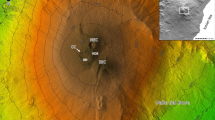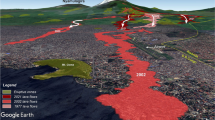Abstract
Mt. Cameroon is one of the most active effusive volcanoes in Africa. About 500,000 people living or working around its fertile flanks are subject to significant threat from lava flow inundation. Lava flow hazard and risk were assessed by simulating probable lava flow paths using the DOWNFLOW code. The vent opening probability density function and lava flow length distribution were determined on the basis of available data from past eruptions at Mt. Cameroon volcano. Code calibration was performed through comparison with real lava flow paths. The topographic basis for simulations was the 90-m resolution SRTM DEM. Simulated lava flows from about 80,000 possible vents were used to produce a detailed lava flow hazard map. The lava flow risk in the area was mapped by combining the hazard map with digitized infrastructures (i.e., human settlements and roads). Results show that the risk of lava flow inundation is greatest in the most inhabited coastal areas comprising the town of Limbe, which constitutes the center of Cameroon’s oil industry and an important commercial port. Buea, the second most important town in the area, has a much lower risk although it is significantly closer to the summit of the volcano. Non-negligible risk characterizes many villages and most roads in the area surrounding the volcano. In addition to the conventional risk mapping described above, we also present (1) two reversed risk maps (one for buildings and one for roads), where each point on the volcano is classified according to the total damage expected as a consequence of vent opening at that point; (2) maps of the lava catchments for the two main towns of Limbe and Buea, illustrating the expected damage upon venting at any point in the catchment basin. The hazard and risk maps provided here represent valuable tools for both medium/long-term land-use planning and real-time volcanic risk management and decision making.















Similar content being viewed by others
References
Annen C, Lénat JF, Provost A (2001) The long-term growth of volcanic edifices: numerical modelling of the role of dyke intrusion and lava-flow emplacement. J Volcanol Geotherm Res 105:263–289
Bonne K, Kervyn M, Cascone L, Njome S, Van Ranst E, Suh E, Ayonghe S, Jacobs P, Ernst G (2008) A new approach to assess long-term lava flow hazard and risk using GIS and low-cost remote sensing: the case of Mount Cameroon, West Africa. Int J Remote Sens 29:6539–6564
Calvari S, Neri M, Pinkerton H (2002) Effusion rate estimations during the 1999 summit eruption on Mount Etna, and growth of two distinct lava flow fields. J Volcanol Geotherm Res 119:107–123
Chirico GD, Favalli M, Papale P, Pareschi MT, Boschi E (2009) Lava flow hazard at Nyiragongo volcano, D.R.C. 2. Hazard reduction in urban areas. Bull Volcanol 71:375–387. doi:10.1007/s00445-008-0232-z
Corsaro RA, Miraglia L, Pompilio M (2007) Petrologic evidence of a complex plumbing system feeding the July–August 2001 eruption of Mt. Etna, Sicily, Italy. Bull Volcanol 69:401–421. doi:10.1007/s00445-006-0083-4
Costa A, Macedonio G (2005) Numerical simulation of lava flows based on depth-averaged equations. Geophys Res Lett 32:L05304. doi:10.1029/2004GL021817
Crisci GM, Iovine G, Di Gregorio S, Lupiano V (2008) Lava flow hazard on the SE flank of Mt. Etna (Southern Italy). J Volcanol Geotherm Res 177:778–796
Crisci GM, Avolio MV, Behncke B, D’Ambrosio D, Di Gregorio S, Lupiano V, Neri M, Rongo R, Spataro W (2010) Predicting the impact of lava flows at Mount Etna, Italy. J Geophys Res 115:B04203. doi:10.1029/2009JB006431
Cruz Mermy D, Lambert A, Thierry P, Stieltjes L, N’ni J, Kouokam E, with the collaboration of Nguéya P, Salley MP, Nkoumbou C, Thieblemont D (2006) Project GRINP-composante 1 Notice des cartes geologiques du Mont Cameroun, Rapport final. BRGM Report RC-54726-FR, Orléans, 216 pp
Déruelle B, N’ni J, Kambou R (1987) Mount Cameroon: an active volcano of the Cameroon Line. Journal of African Earth Sciences 6:197–214
Déruelle B, Bardintzeff JM, Cheminée JL et al (2000) Eruptions simultane´es de basalte alcalin et de hawaiite au Mont Cameroun, 28 mars–17 avril 1999. Comptes rendus de l’Académie des Sciences, Série II. Sciences de la terre et des Planètes 331(8):525–531
Favalli M, Pareschi MT, Neri A, Isola I (2005) Forecasting lava flow paths by a stochastic approach. Geophys Res Lett 32. doi:10.1029/2004GL021718
Favalli M, Chirico GD, Papale P, Pareschi MT, Coltelli M, Lucana N, Boschi E (2006) Computer simulations of lava flow paths in the town of Goma, Nyiragongo volcano. Democratic Republic of Congo. J Geophys Res 111. doi:10.1029/2004JB003527
Favalli M, Chirico GD, Papale P, Pareschi MT, Boschi E (2009a) Lava flow hazard at Nyiragongo volcano, D.R.C. 1. Model calibration and hazard mapping. Bull Volcanol 71:363–374. doi:10.1007/s00445-008-0233-y
Favalli M, Mazzarini F, Pareschi MT, Boschi E (2009b) Topographic control on lava flow paths at Mount Etna, Italy: Implications for hazard assessment. J Geophys Res 114:F01019. doi:10.1029/2007JF000918
Favalli M, Tarquini S, Fornaciai A, Boschi E (2009c) A new approach to risk assessment of lava flow at Mount Etna. Geology 37(12):1111–1114. doi:10.1130/G30187A
Felpeto A, Ortiz R, Astiz M, García A (2001) Assessment and modelling of lava flow hazard on Lanzarote (Canary Islands). Natural hazards 23:247–257
Fitton JG (1987) The Cameroon Line, West Africa: a comparison between oceanic and continental alkaline volcanism. In: Fitton JG and Upton BGJ (eds) Alkaline igneous rocks. Geological Society Special Publication 30:273–291
Fitton JG, Kilburn CRJ, Thirlwall MF, Hughes DJ (1983) 1982 eruption of Mount Cameroon, West Africa. Nature 306:327–332
Flynn LP, Harris AJL, Wright R (2001) Improved identification of volcanic features using Landsat 7 ETM+. Remote Sens Environ 78:180–193
Gèze (1953) Les volcans du Cameroun occidental. Bull Volcanol 13:63–92
Giordano D, Polacci M, Longo A, Papale P, Dingwell BD, Boschi E, Kasereka M (2007) Thermo-rheological magma control on the impact of highly fluid lava flows at Mt Nyiragongo. Geophys Res Lett 34. doi:10.1029/2006GL028459
Grosse P, van Wyk de Vries B, Petrinovic I, Euillades PA, Alvarado GE (2009) Morphometry and evolution of arc volcanoes. Geology 37:651–654. doi:10.1130/G25734A.1
Guest JE (1982) Styles of eruption and flow morphology on Mount Etna, Mem. Soc Geol Ital 23:49–73
Harris AJL, Rowland SK (2001) FLOWGO: A kinematic thermo-rheological model for lava flowing in a channel. Bull Volcanol 63:20–44. doi:10.1007/s004450000120
Hubbard BE, Sheridan MF, Carrasco-Núñez G, Díaz-Castellón R, Rodríguez SR (2007) Comparative lahar hazard mapping at Volcan Citlaltépetl, Mexico using SRTM, ASTER and DTED-1 digital topographic data. J Volcanol Geotherm Res 160:99–124. doi:10.1016/j.jvolgeores.2006.09.005
Huggel C, Schneider D, JulioMiranda P, Delgado Granados H, Kääb A (2008) Evaluation of ASTER and SRTM DEM data for lahar modeling: a case study on lahars from Popocatépetl Volcano, Mexico. J Volcanol Geotherm Res 170:99–110. doi:10.1016/j.jvolgeores.2007.09.005
Karátson D, Favalli M, Tarquini S, Fornaciai A, Wörner G (2010) The regular shape of stratovolcanoes: A DEM-based morphometrical approach. J Volcanol Geotherm Res 193:171–181. doi:10.1016/j.jvolgeores.2010.03.012
Kauahikaua J, Margriter S, Lockwood J, Trusdell F (1995) Applications of GIS to the estimation of lava fl ow hazard on Mauna Loa Volcano, Hawaii. In: Rhodes JM & Lockwood JP (eds) Mauna Loa revealed: structure, composition, history, and hazards. American Geophysical Union Geophysical Monograph 92: 315–325
Lopes R, Guest JE (1982) Lava flows on Etna: a morphometric study. In: Coradini A, Fulchignoni MD (eds) The comparative study of planets. Reidel, Dordrecht, pp 441–458
Lu Z, Rykhusa R, Masterlarka T, Ken G, Deanb KG (2004) Mapping recent lava flows at Westdahl Volcano, Alaska, using radar and optical satellite imagery. Remote Sens Environ 91:345–353
Marzoli A, Piccirillo EM, Renne PR, Bellieni G, Iacumin M, Nyobe JB, Tongwa AT (2000) The Cameroon Volcanic Line revisited: petrogenesis of continental basaltic magmas from lithospheric and asthenospheric mantle sources. J Petrol 41:87–109
Mathieu L, Kervyn M, Ernst GGJ (2011) Field evidence for flank instability, basal spreading and volcano-tectonic interactions at Mt Cameroon. West Africa Bull Volcanol. doi:10.1007/s00445-011-0458-z
Njome MS, Suh CE, Sparks RSJ, Ayonghe SN, Fitton JG (2008) The Mount Cameroon 1959 compound lava flow field: morphology, petrography and geochemistry. Swiss Journal of Geosciences 101:85–98
Nkono C, Féménias O, Demaiffe D (2009) Geodynamic framework of large volcanic fields highlighted by SRTM DEMs: Method evaluation and perspectives exampled on three areas from the Cameroon Volcanic Line. J Volcanol Geotherm Res 187:13–25. doi:10.1016/j.jvolgeores.2009.06.007
Polacci M, Papale P (1999) The development of compound lava fields at Mount Etna. Physics and Chemistry of the Earth, part A-solid Earth and Geodesy 24:949–952. doi:10.1016/S1464-1895(99)00140-4
Regnoult JM, Moreau C, Duruelle B (1986) Un nouveau module tectonique pour la “Ligne du Cameroun”. Ann. Fac. Sci. Univ. Yaoundé, Nouv. Sér
Silverman BW (1986) Density estimation for statistics and data analysis. Chapman & Hall, London
Suh CE, Sparks RSJ, Fitton JG, Ayonghe SN, Annen C, Nana R, Luckman A (2003) The 1999 and 2000 eruptions of Mount Cameroon: eruption behaviour and petrochemistry of lava. Bull Volcanol 65:267–281
Suh CE, Stansfield SA, Sparks RSJ, Njome MS, Wantim MN, Ernst GGJ (2011) Morphology and structure of the 1999 lava flows at Mount Cameroon Volcano (West Africa) and their bearing on the emplacement dynamics of volume-limited flows. Geol Mag 148:22–34. doi:10.1017/S0016756810000312
Tarquini S, Favalli M (2010) Changes of the susceptibility to lava flow invasion induced by morphological modifications of an active volcano: the case of Mount Etna, Italy. Nat Hazards 54:537–546. doi:10.1007/s11069-009-9484-y
Tarquini S, Favalli M (2011) Mapping and DOWNFLOW simulation of recent lava flow fields at Mount Etna. J Volcanol Geotherm Res 204:27–39. doi:10.1016/j.jvolgeores.2011.05.001
Tazieff H (1977) An exceptional eruption: Mt. Nyiragongo, Jan. 10th, 1977. Bull Volcanol 40:189–200
Thierry P, Stieltjes L, Kouokam E, Nguéya P, with the collaboration of Arnal C, Gehl P, Salley MP (2006) Project GRINP-composante 1 Réalisation d’une carte de zonage des risques du Mont Cameroun Rapport final. BRGM Report RC-54727-FR, Orléans, 333 pp
Thierry P, Stieltjes L, Kouokam E, Nguéya P, Salley PM (2008) Multi-hazard risk mapping and assessment on an active volcano: the GRINP project at Mount Cameroon. Nat Hazards 45:429–456
Toteu SF, Penaye J, Poudjom Djomani YH (2004) Geodynamic evolution of the Pan-African belt in Central Africa with special reference to Cameroon. Canadian Journal of Earth Sciences 41:73–85
Van Ranst E, Hof J, Kips PhA, Awah ET, Zambo J (1989) Volcanic soils of the lower south eastern and eastern slopes of Mount Cameroon (West Africa). Research project UCD Technical Report Dschang, Ministry of Higher Education, Computer Services and Scientific Research
Wadge G, Young PAV, McKendrick IJ (1994) Mapping lava flow hazard using computer simulation. J Geophys Res 99:489–504. doi:10.1029/93JB01561
Walker GPL (1971) Compound and simple lava flows and flood basalts. Bull Volcanol 35:579–590
Wright R, Garbeil H, Baloga SM, Mouginis-Mark PJ (2006) An assessment of shuttle radar topography mission digital elevation data for studies of volcano morphology. Remote Sens Environ 105:41–53. doi:10.1016/j.rse.2006.06.002
Wright R, Garbeil H, Harris AJL (2008) Using infrared satellite data to drive a thermo-rheological/stochastic lava flow emplacement model: a method for near-real-time volcanic hazard assessment. Geophys Res Lett 35:L19307. doi:10.1029/2008GL035228
Acknowledgments
This work was partly funded by the Dipartimento della Protezione Civile (Italy) in the frame of the 2007–2009 Agreement with Istituto Nazionale di Geofisica e Vulcanologia. S.T. benefited from the MIUR-FIRB project “Sviluppo di nuove tecnologie per la protezione e difesa del territorio dai rischi naturali (FUMO)” and A. F. from the MIUR-FIRB project “Piattaforma di ricerca multi-disciplinare su terremoti e vulcani (AIRPLANE)” n. RBPR05B2ZJ. Pierre Thierry (BRGM, France) and Oscar Matip (Director of Mines and Geology/Cameroonian Ministry of Mines) are gratefully acknowledged for providing the BRGM report RC-54727-FR. Reviews from J. Kauahikaua and an anonymous reviewer significantly improved the quality of this paper.
Author information
Authors and Affiliations
Corresponding author
Additional information
Editorial responsibility: R. Cioni
Rights and permissions
About this article
Cite this article
Favalli, M., Tarquini, S., Papale, P. et al. Lava flow hazard and risk at Mt. Cameroon volcano. Bull Volcanol 74, 423–439 (2012). https://doi.org/10.1007/s00445-011-0540-6
Received:
Accepted:
Published:
Issue Date:
DOI: https://doi.org/10.1007/s00445-011-0540-6




